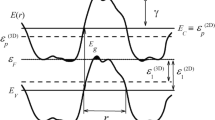Summary
A high-resolution X-ray diffractometer equipped with an accurateX-Y translation stage has been used to obtain Bragg angle maps of large-area crystal wafers. It is found that the Bragg angle shifts observed by this method in conventional reflection geometries are mainly due to the local lattice tilts rather than to the lattice parameter changes. The formula to calculate from the lattice tilt maps the displacement of the crystal lattice sites with respect to the ideal unperturbed lattice is obtained. It is shown that such lattice displacement is quantitatively correlated to the wafer dislocation density and to the distribution of the Burgers vectors of the dislocations in the crystal. Semi-insulating Czochraslki-grown GaAs wafers with dislocation densities ranging from 104 to 105cm−2 have been analysed by this technique and by double-crystal X-ray topography. From the lattice tilt maps the dislocation density evaluated appeared similar to those determined by topography and etch pit density in this material. It is concluded that the majority of dislocations in the wafer have the same Burgers-vector component along the (100) growth axis. Finally the method is proposed as a new tool for characterizing large-area wafer crystals.
Similar content being viewed by others
References
Hart M.,J. Cryst. Growth,55 (1981) 409.
Barnett S. J., Brown G. T. andTanner B. K.,Inst. Phys. Conf. Ser., No. 87 (1987) 615.
Ishikawa T., Kitano T. andMatsui J.,J. Appl. Cryst.,20 (1987) 344.
Kikuta S., Kohra K. andSugita Y.,Jpn. J. Appl. Phys.,5 (1966) 1047.
Ferrari C. andKorytar D., submitted toJ. Appl. Phys.
Knauer A., Krausslich J., Kittner R., Starke R. andBärwolf A.,Cryst. Res. Technol. 25 (1990) 441.
Zakharov S. N., Laptev S. A., Kaganer V. M., Bublik V. T. andIndenbom V. L.,Phys. Status Solidi A,131 (1992) 143.
Sugii S., Koizumi H. andKubota E.,J. Electron. Mater.,12 (1983) 701.
Indenbom V. L. andKaganer V. M.,Phys. Status Solidi A,118 (1990) 71.
Indenbom V. L. andKaganer V. M.,Phys. Status Solidi A,122 (1990) 97.
Hull D. andBacon D. J., inIntroduction to Dislocations, 3rd edition (Pergamon Press, Oxford) 1994, p. 20.
Ferrari C. andFranzosi P.,Inst. Phys. Conf. Ser., No.117 (1991) 673.
Jenichen B., Kölher R. andMöhling W.,Phys. Status Solidi A,89 (1985) 79.
Jordan A. S., Caruso R. andVon Neida A. R.,Bell Syst. Tech. J.,59 (1980) 593.
Schlossmacher P., Rufer H. andUrban K.,Inst. Phys. Conf. Ser., No.116, (1991) 337.
Matsui V.,Appl. Surf. Sci.,50 (1991) 1.
Author information
Authors and Affiliations
Rights and permissions
About this article
Cite this article
Ferrari, C., Korytar, D. & Kumar, J. Study of residual strains in wafer crystals by means of lattice tilt mapping. Nouv Cim D 19, 165–173 (1997). https://doi.org/10.1007/BF03040969
Received:
Accepted:
Issue Date:
DOI: https://doi.org/10.1007/BF03040969
PACS
PACS
- 61.72.Hh
- Indirect evidence of dislocations and other defects (resistivity, slip, creep, strains, internal friction, EPR, NMR, etc.)




